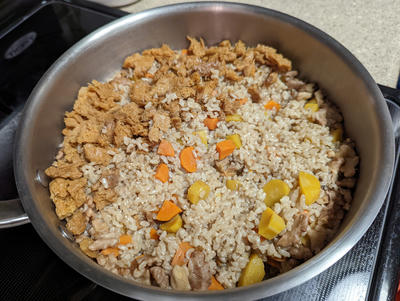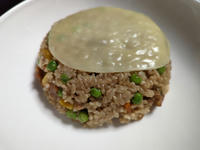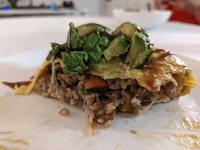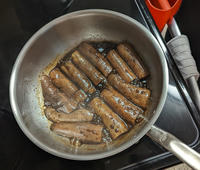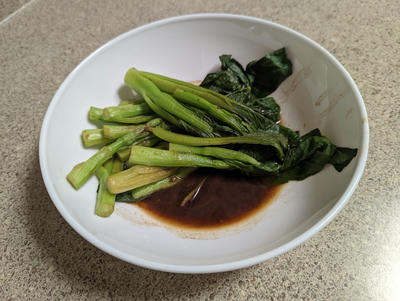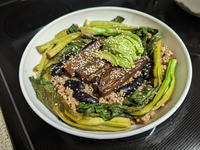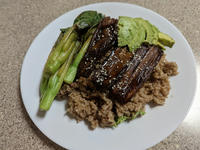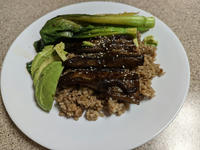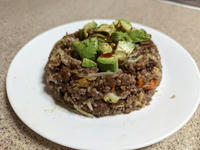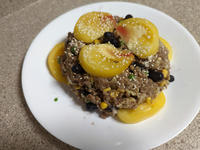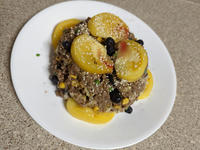Weekly Dinner for Two
Rice Extravaganza🔗
This is a post long overdue. Usually I keep adding to the same commit if a theme is ongoing and push the commit when the theme is concluded. Usually the staging time is a week. That's where the template "Weekly Dinner for Two" is from. However, recently I've been making rice so often that the rice commit gets ever bigger. For better post practice, I feel it's time to push the never ending theme and share with you what I call rice extravaganza.
You probably sense the humor of speech here. Rice is the opposite of extravaganza. It's so plain, even boring to some people. But I manage to make it so exciting that it's a hooray for us when it's rice day.
Growing up eating rice almost every single day, you don't think about what goes with rice. Everything goes with rice. It's a white blankie. You just put dishes on it and eat together. Some dishes make you eat more rice, therefore the nickname Xia Fan Cai, meaning dish that flushes rice down. Bottom line is that rice is a constant, invariant to dishes. In this regard, rice is much simpler to handle than pasta. As for pasta, you need to think about pairing different shapes with sauce and topping. There are conventions to follow and they do make sense. You cannot go anyway. As much as I like pasta, the convenience and versatility of rice is just hard to beat. So that's my attitude towards rice as a native eater.
How about the attitude from nonnative eaters? By observing A, I've found some interesting patterns. (Please take it lightly. May be over-generalizing. Just personal observations.)
- When it comes to Chinese food, the first thing that comes to their mind is fried rice. It's almost a must-order item either at a restaurant or takeout.
- Without a rice cooker, rice cooking is a mysterious thing to them. "How to make perfectly cooked rice" can be an essay topic requiring quite some research. Whether you feel amusing or agreeing to the above arguments, hopefully what's coming next will change your perspective.
Let's start with 2. Cooking rice is not as intimidating as you'd think. You don't need a fancy rice cooker, or precise measurements, or perfect timing. Only a couple of guidelines and you are good to go.
- First and foremost, the ratio. For whatever type of rice, I always start with 1:2 rice to water by weight. It may need adjustment later depending on the doneness when water is gone. But 1:2 is a good starting point. If it's on the hard side when water is gone, just add some more water and keep cooking. If it's done but there is still water, unlid and turn on the heat a bit to speed up evaporation. Ratio varies for different types or even different brands of rice. As long as you know how to adjust from the baseline, it's really easy to get it right.
- Rinse till water is clean It's for removing starch so after cooking rice kernels don't clump together. It's extra helpful if planning to make fried rice the next day. Starch content may vary for different types. I find brown rice, which is my default, has quite some starch that needs a couple of rounds rinsing. White rice may need less.
- High heat till boil and low heat till done In terms of timing, it depends on how much rice and how big the pot etc. I usually stay around at the beginning of the high heat stage until water boils. Then lower heat to a gentle simmer, keep the lid on and walk away. Check back after 20min and monitor the water level. Once there is no extra water on the surface, turn off the heat, slightly unlid and let it sit until serving.
Overall, the above simple method gives consistently satisfying results. Is it the perfect cooked rice? Who is to say what's perfect? Just like Al-dente for pasta, some may like mushier rice while others prefer harder. Every time when unlid before serving, I'm greeted by the enticing steam and amazed by the fluffy texture. To me, it's perfect enough.
Now that we've covered the basics, here is the bonus tip that elevates plain rice to fancy rice. It's to add some add-ons (or I should call add-ins) to cook with rice together. They either provide additional texture or flavor or both. The add-ons fall into three categories.
- Nuts: cashews, walnuts, almonds Cooked nuts have a very nice texture, soft and creamy. They also release a nutty flavor to rice.
- Dried fruits: raisins I'm a sweet and savory person. It's always nice to have a sweet note around.
- Aromatics: ginger, garlic Ginger of any form under heat instantaneously wins sniffing and "Mmmm... It smells good". Yep, ginger is potent. Its aroma is very reminiscent of what I consider Chinese home cooking. Basically it reminds me of what every window smells like at dinner time back home.
I started doing fancy rice once I had abundant pantry stuff and wanted to make use of them. After discovering how good it is, it became my default way of making rice. I don't always have all three categories at hand. But even one of two will upgrade rice to the goodness level that you can have by itself without any dish and still enjoy quite a lot.
Now we have fancy rice that you are happy to eat by itself. Let the rice extravaganza begin.
First Day Steamed Rice🔗
Say your plan is to make fried rice, which to many including A is the most appealing form of rice. But as we've discussed in an earlier post, fried rice is really the job for second day rice. Then what do you do on the first day with the fresh steaming rice? I have two excellent options.
Omurice🔗
Omurice is from Japan, which basically means omelet rice. There is a famous chef doing showy version of torpedo shaped omelet blossoms on top of a rice dome. We don't have to master that high skill cap technique to have similar taste or even look. IMO, this is perfect for those who really crave for fried rice from day one. You get most of the fried rice hits, just more steamy.
Make fancy rice as described above. Pro tip, you can bundle in some quick cook or cooked protein at the end of rice cooking to make everything-included rice pot. Protein choices can be shrimp, cooked sausage, any veggie meat, etc.
When rice is done, grab a pan to make an omelet, except not to fold or roll it. Just keep pushing the cooked egg to the center and letting the uncooked egg run to the edge until everything is set. You then have a sheet of omelet. Let it slide on top of the rice dome. Optionally, you could sneak in a slice of cheese between rice dome and omelet, upgrading to cheesy omurice. To finish up, you can use any fresh stuff at hand, like avocado or tomato. Optional, drizzle some Japanese bbq sauce for a sweet savory kick.Eggplant and Green🔗
Instead of assembling everything into a platter as what we usually do, Chinese cooking has the notion of "dish". Every meal has a couple of dishes for the table and everyone grabs dishes onto their bowl of rice. This recipe is more traditional in terms of the dish framework. For a family of two on weeknights, a two-dish meal is just what we need. The eggplant dish is a strong flavor main dish and the green is a light side dish. Normally the main dish is meat centric. As the eggplant is cooked in a way that's both texture wise meaty and flavor wise umami. So you can take it as a very creative meat replacement.
Although nowadays we rarely go to grocery stores to shop in person (online is just way easier), all the ingredients here were actually handpicked (how special) during my recent trip to a Chinese supermarket. I got some of my favorite Chinese veggies: yellow chives, eggplants and Yu Choy (not how it's called in Shanghai but we have similar varieties, somewhere between Bok Choy and Gailan, mildly sweet and extra crunchy). Eggplants and Yu Choy are used here, and yellow chives in fried rice.
The eggplant dish is inspired by Eggplant Unagi. The idea is to braise eggplants so it's deeply flavored and extra succulent. Eggplant has a spongy texture that's perfect for braising, the same way you'd do with meat, just much shorter time. It soaks up lots of sauce during braising that becomes succulent and flavorful. It tastes so meaty and umami that you wouldn't miss meat at all. This is what I consider the culmination of the veggie centerpiece dish, no meat but more than meat.
To make the eggplant dish, just follow the steam-and-braise process.
- Steam eggplants until very soft. Either microwave (recommended, 5min on high covered to trap steam) or stovetop steaming (20min)
- Lightly pan fry (optional) and then braise under gentle simmer for 20min, or until sauce is reduced to thick glassy consistency.
The sauce measurement is as usual by feel. The only rule of thumb is to gather the seasonings that cover the following flavor profile.
- umami: soy sauce
- acidic: vinegar, pickles
- sweet: sugar, honey
- aromatic: garlic, onion
Or you can use compound seasonings or special ingredients to bring extra flavor, e.g.
- oyster sauce: umami, sweet
- ketchup: sweet, acidic
- bbq sauce: umami, sweet
- olives: funky flavor
- sardine: seafood flavor
Use what you have and what you like. Taste as you go. It's gonna be good for your likings.
To make the green side dish, it couldn't be more simpler. For Yu Choy and similar Chinese greens like Bok Choy or Gailan. Just do a quick 30sec blanching in boiling water. Remember the eggplant braising sauce left in the pan. Here's a trick to clean the pan at the same time season the green. Just pour some hot water, vinegar and sesame oil into the pan to deglaze, aka clean. Then pour the pan sauce on top of blanched green. Viola, you have a well-seasoned and brightly refreshing side green dish.
We still plate the usual way. But it's a legit Chinese style two-dish meal.
Fried Rice Anything🔗
Fried rice is Chinese mac'n'cheese, the absolute kids (and adults like us) favorite. It's quick, convenient and delicious. What's not to love? Back to observation 1. of nonnative rice eater: Always ordering fried rice as default. Because fried rice is so humble and approachable, native rice eaters rarely order it outside. It's an anytime satisfying event at home. You can use almost anything and it's always good. For fried rice add-ons, frozen corns and peas are your best friends. They make it truly anytime. Did I tell you I have stocked at least 10 bags of them in the freezer? You can also make it anyway by using creative add-ons. Here are two examples.
Yellow Chives🔗
Yellow chive and egg is one of my favorite classic home dishes. Extremely fragrant and tender chives go so well with scrambled eggs. So, it's not surprising that yellow chives make a perfect fried rice add-on.
Got Any Grapes🔗
As featured in "Got Any Grape" pizza already, I'm a big fan of using grapes to build sweet elements. If you haven't put raisins in fancy rice, now it's the time to enter the grape game. Throw in some grapes at the last minute of stir fry. I guarantee when the sweet pouch bursts in your mouth soaking into rice. It's gonna win a big wow.
Final words: May the rice be with you!
